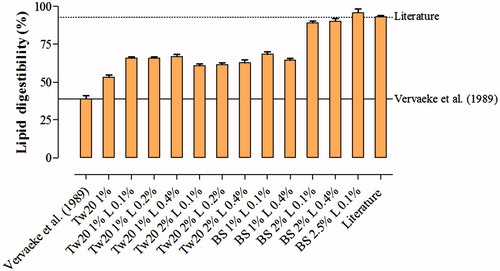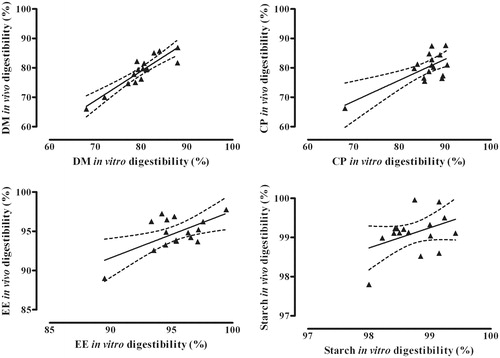Figures & data
Table 1. Chemical composition (% on DM basis) of the four dog foods used during the development of the in vitro digestion method.
Table 2. Chemical composition (% on DM basis) of the 16 dry dog foods used for the validation of the in vitro method.
Table 3. In vitro digestibility (mean values ± SD) of three dry extruded diets for adult dogs as determined using the method proposed by Vervaeke et al. (Citation1989) and literature data.
Figure 1. In vitro lipid digestibility of a sample of wet canned food for adult dogs as determined using different combinations of gastric lipase and emulsifiers and literature data. The dotted line indicates the mean of results drawn from the literature (Dust et al. Citation2005; Yamka et al. Citation2006; Vhile et al. Citation2007; Kempe and Saastamoinen, Citation2007; Guevara et al. Citation2008; Barry et al. Citation2009; Dobenecker et al. Citation2010; Brambillasca et al. Citation2010; Hendriks et al. Citation2013; Menniti et al. Citation2014) while the solid line indicates results obtained with the technique proposed by Vervaeke et al. (Citation1989) with no addition of gastric lipase and emulsifiers. BS: Bile salts (cholic acid-deoxycholic acid sodium salt mixture); Tw20: Polysorbate 20 (polyoxyethylene sorbitan monolaurate; Tween 20, Sigma Aldrich); L: Gastric lipase.

Table 4. In vitro digestibility (mean values ± SD) of a wet canned food for adult dogs as determined using different concentrations of pancreatin (g/L of phosphate buffer) and bile salts (g/L of total volume of digestive solutions) and literature data.
Table 5. In vitro digestibility (mean values ± SD) of a dry extruded food for adult dogs as determined using different durations of the gastric digestive phase and literature data.
Figure 2. Relationship between digestibility of dry matter (DM), crude protein (CP), ether extract (EE) and starch of 16 dry extruded pet food samples determined in vivo (n = 5) and in vitro (n = 3). In vivo DM digestibility (%) = −1.15 + 1.00 ± 0.13 in vitro DM digestibility (%); r2 = .810; p < .001. In vivo CP digestibility (%) = 18.7 + 0.71 ± 0.19 in vitro CP digestibility (%); r2 = .510; p < .01. In vivo EE digestibility (%) = 37.8 + 0.60 ± 0.20 in vitro EE digestibility (%); r2 = .383; p < .05 In vivo starch digestibility (%) = 48.2 + 0.52 ± 0.31 in vitro starch digestibility (%); r2 = .161; p > .05.

